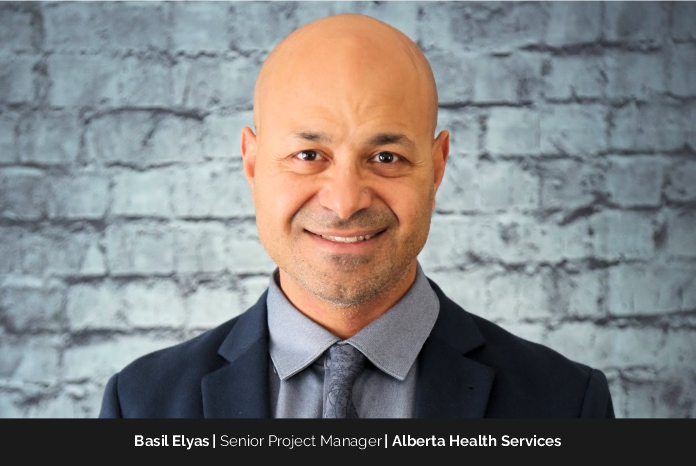Alberta Health Services (AHS) is part of Canada’s first and largest province-wide, integrated health system. As Senior Project Manager at AHS, Basil Elyas leads some of Alberta’s most complex healthcare projects. These initiatives generate real value, reduce variation, drive clinical appropriateness, and improve patient outcomes. He helps drive improvements in both clinical and support services. In addition to his impeccable work, what also sets Basil apart is the way he leads.
Known for his servant-leadership approach, he supports colleagues, removes barriers, and models calm under pressure. He also anchors every project with clear, documented objectives and a well-defined schedule of deliverables. These keep him and his team aligned and focused, even during uncertainty.
Basil is also the founder of Excellence Sigma Academy which is a training and consulting firm focused on Lean Six Sigma and continuous improvement.
Taking the Unconventional Path
Basil’s journey to healthcare project leadership has been unconventional. He began his career as a geneticist, spending over 15 years in a clinical molecular genetics laboratory. According to him, in the lab, he had the privilege of doing “incredible work” alongside inspiring leaders and colleagues.
It was while leading lab-focused projects that his interest in structured project management was first sparked. He eventually earned his PMP designation, which provided him with a solid foundation in formal methodologies. However, the turning point in Basil’s career came when an external evaluator visited his lab. He recalls that the evaluator was a Six Sigma Black Belt. When he first heard that, he laughed, thinking she had invented the title.
“But when I looked into it, the methodology deeply resonated with me because of its focus on data, process improvement, and measurable results,” he says. So, he pursued certification and became an American Society for Quality (ASQ) Certified Six Sigma Black Belt. Basil points out that this expanded his career horizon significantly.
“Within a year, I moved out of the laboratory into a leadership role focused on large-scale healthcare improvement initiatives,” he says.
In 2013, Basil moved to AHS from the Molecular Diagnostics Laboratory. Since then, he has been leading strategic projects and multidisciplinary teams across the organization. According to him, over the years, his role has continued to evolve — from focusing on project execution, to shaping strategy, mentoring new professionals, and helping build a culture of continuous improvement.
“What inspires me most today is seeing the tangible impact of this work,” Basil says, “not only how it improves workflows for healthcare practitioners and staff, but also how it ultimately makes a difference in the lives of patients and families.”
“That is what continues to drive me and makes this work so meaningful,” he adds.
In 2018, Basil launched Excellence Sigma Academy. It allows him to share his passion for Lean Six Sigma and project leadership more broadly with other industries beyond healthcare.
The First Milestone
For Basil, his first milestone was obtaining the Project Management Professional (PMP) designation. “It shaped my leadership journey,” he says.
Although he didn’t fully realize its significance at the time, Basil later discovered that his natural approach to projects closely aligned with the best practices established by PMI. It was a natural fit. Earning the designation then gave him professional credibility and confidence to take on high-profile, high-stakes projects.
“I often think of it as one of the pillars in my leadership structure,” he says. Since then, he has added other pillars, such as becoming an ASQ Certified Six Sigma Black Belt and a Prosci Certified Change Management Practitioner. He points out that each pillar has strengthened his ability to lead complex initiatives, not just within Alberta Health Services but also through Excellence Sigma Academy, and in partnership with organizations like ASQ and PMI.
“But it all started with the PMP,” Basil says. “This first milestone set me on a path of continuous growth, and it taught me the importance of building credibility, investing in professional development, and aligning passion with purpose.”
Managing the Most Complex Project
At AHS, Basil led a large and diverse portfolio through the adoption and implementation of the Clinical Information System (electronic medical record). “It was over two years (2022-24) through five phases,” he points out.
He explains that the users were primarily food services, environmental services, and patient transport team members, and each launch required hundreds of users to adopt the new system. Several factors made this process exceptionally complex. For example, each group had different views of the system. So, they required their own unique change management, training, and equipment needs. This demanded significant project management, communication, and problem-solving, according to Basil.
Another complication was especially experienced by the food services team members. The new system required major changes to how the team did their work. Ironically, moving to these systems multiplied the amount of their paperwork by 10-fold. Basil says that this was the hardest part of the project, but it was also the most rewarding. It required leadership and engagement with team members locally and often.
“I was so proud of all the groups for adopting the new system and for the team that supported the adoption,” Basil says. “One of my favorite things to hear was ‘that was not as bad as I thought it would be’.”
He also says that one can read about managing large-scale projects in a book, but when one lives through one, they realize success depends on meeting people where they are, helping them navigate disruption, and leading with empathy. “That experience stretched me in the best way and deepened my belief that leadership is about creating the conditions for others to succeed,” Basil says.
Developing Project Trackers and Dashboards
Basil has developed numerous project trackers, which enable him to track the activities and status of multiple projects at the same time. In addition to that, he has developed several dynamic project dashboards.
“There is one tool that I have found people really value,” Basil says.” It is a one-page tool, with the top part being a project timeline.” This allows stakeholders to see the activities that are happening in a window of time. Also, the lower half of the tool gives space in a table format for people to provide details about the activities. Basil explains that this simple yet dynamic format helps the project team stay organized, enables him to quickly identify risks or delays, and makes it much easier to share clear, concise updates with senior leaders.
“These tools not only improve project execution but also strengthen accountability and engagement across teams,” he says.
Strategic Decision-Making When Managing Multidisciplinary Team
Basil has led numerous multidisciplinary teams. According to him, humility is the key to strategic decision-making when managing such a team.
He understands that no one person has all the answers, least of all the project lead. “Each team member is there because of the expertise they bring, and effective decisions come from drawing on that knowledge,” he points out. He makes a deliberate effort to engage team members in the way that works best for them. It requires deep emotional intelligence. Basil says that the core aspects of this are understanding different communication styles, listening actively, and reading between the lines to surface unspoken concerns.
Basil has also learned that good decision-making doesn’t happen by accident, but it has to be planned for. That means building decision points into the project schedule, giving people the right information in advance, and being explicit in meetings when a decision is required. “This creates clarity, reduces delays, and ensures that strategic choices are well-informed, collaborative, and timely,” Basil says.
Following the Philosophy of Servant Leadership
“The philosophy that most influences how I lead and collaborate is servant leadership,” Basil says.
In his role, he creates the conditions for others to thrive and succeed. He is known for removing barriers, listening actively, and supporting the team so they can perform at their best. At the core of his approach are empathy and emotional intelligence. Basil says that he takes the time to understand team members’ perspectives, recognizes the pressures and challenges they face, and responds in ways that build trust, confidence, and resilience.
“Leading with empathy allows me to foster stronger collaboration and ensure that every voice is heard, from frontline staff to patients and families,” he explains. As a result, an environment is created where people feel safe to contribute ideas, raise concerns, and take ownership of solutions. It leads to higher engagement and morale and greater accountability, which directly drives project outcomes to be achieved and sustained.
Ultimately, leadership is less about authority and more about service. Basil says, “When teams feel truly supported and valued, they consistently deliver meaningful improvements in healthcare and better outcomes for patients.”
4 Trends Shaping the Future of Healthcare Project Management
Basil notes four major trends shaping the future of healthcare project management. First is the continued expansion of digital health, such as telemedicine, remote monitoring, and EHR interoperability. Basil points out that it is transforming how care is delivered and coordinated. The adoption of digital health accelerated during the COVID-19 pandemic when there was limitations to in-person clinical visits due to lockdown.
The second trend, Basil points out, is the rise of artificial intelligence (AI) and advanced analytics, which are reshaping clinical decision support and operational efficiency. Although there will always be a need for good clinical judgment, AI is rapidly becoming a powerful tool supporting clinical decision-making, according to him.
“Both those trends require project leaders to manage highly technical, fast-evolving initiatives that directly affect care delivery,” Basil says.
The shift toward value-based, patient-centered care is the third trend he notes. He explains that this means projects must demonstrate measurable improvements in outcomes, efficiency, and patient experience, not just meet traditional delivery metrics.
And the fourth trend is challenges related to the workforce, such as staffing shortages and clinician burnout. According to Basil, to overcome these challenges, project management needs to focus heavily on people through strong change management, stakeholder engagement, and support for frontline staff.
Mentoring Emerging Leaders
Basil’s Six Sigma training and project experience have ingrained in him the importance of mentorship. According to him, some of his most rewarding experiences have come from one-to-one coaching of Green Belts as they complete their projects and training, in addition to coaching aspiring project managers when they take on new responsibilities. For Basil, mentorship means much more than overseeing people’s work or holding them accountable. He believes it is about building a genuine relationship, showing them that they matter and that their success matters to him.
Basil also mentors emerging project leaders by modeling best practices and, even more importantly, modeling soft skills such as empathy, active listening, and clear communication. He explains that when they see these behaviors demonstrated consistently, it reinforces what leadership looks like in practice.
“By combining structured coaching with role modeling,” Basil says, “I aim to develop not only capable project managers, but also compassionate, people-centered leaders who are ready to take on greater responsibilities.”
Advice for Young Professionals
Basil has four key pieces of advice for young professionals aspiring to leadership roles in healthcare systems and project management. “First, the tool needs to work for you, not you for the tool,” he says.
He explains that young professionals should be familiar with various project tools (artifacts), such as a project charter, communication plan, and risk register. However, he also points out that such tools need to serve them and team, not the other way around. “Tailor the tool to meet your needs, the team’s needs, and the needs of the project,” he says.
“Strive to become a servant leader” is Basil’s second piece of advice. He says that young professionals can learn the science of project management and analytics, but true impact comes only from being a servant leader. He encourages them to support and defend every individual on their team, as well as remove barriers for them.
Basil’s third piece of advice is about deliberate planning and implementing change management. He explains that project managers are change makers, as virtually all projects change the way a person or a group works. This change, he says, needs to be planned for and be part of the project implementation.
“Lastly, above all, keep the patient at the center, because leadership in healthcare is about more than achieving project goals,” Basil advises young professionals. “It is about creating lasting value for patients, their families, and the public.”
Reforming the Healthcare System
If given the opportunity to reform an aspect of the healthcare system, Basil would focus on improving care coordination and integration. He points out that patients often experience fragmented and inconsistent care. They have to move between primary care providers, hospitals, specialists, and community services without seamless communication or adherence to best practices.
Some of the consequences of fragmented and inconsistent care include inefficiencies, unnecessary testing, delays, and poorer outcomes. In order to improve both patient experience and system sustainability, Basil believes that there needs to be investment in interoperable digital health systems, standardized processes, and stronger cross-disciplinary collaboration.
“Better coordination not only reduces duplication and costs but also ensures patients feel supported throughout their entire care journey,” he says. “Ultimately, integration is the cornerstone of delivering truly patient-centered, value-based care.”
**************
For inquiries, please contact Basil Elyas at: excellencesigmaacademy@gmail.com





